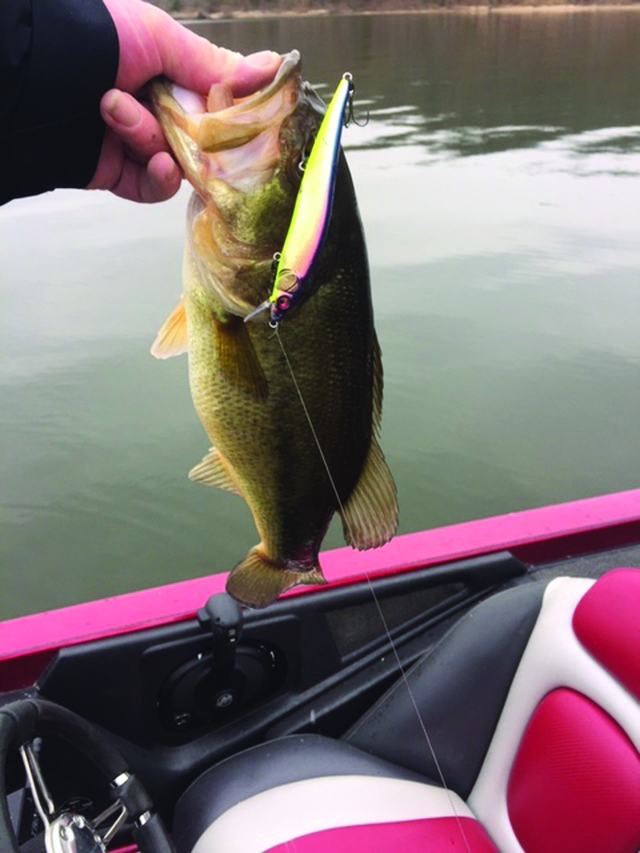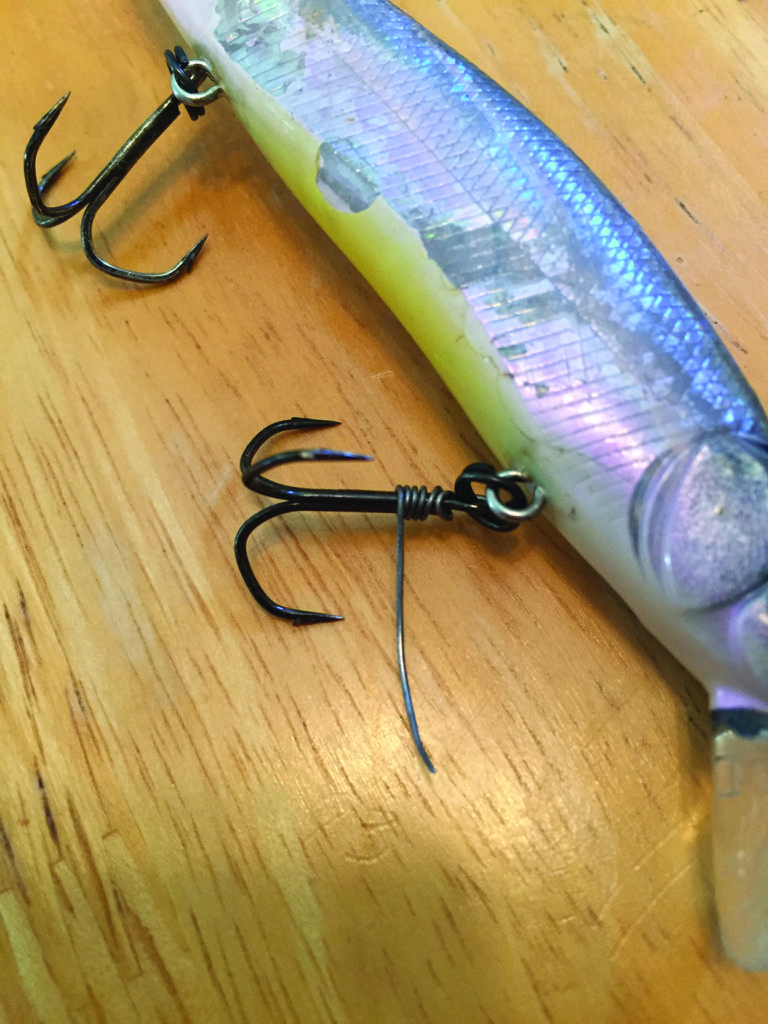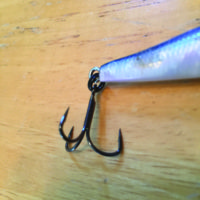Demystifying the Jerkbait
 The suspending jerk bait is synonymous with wintertime fishing here in the Ozarks. At this time, many of the bass can be found around schools of suspending shad. Many of these shad will begin to die off as the water cools into wintertime temperatures, providing an easy meal for bass and other game fish. The jerkbait is the perfect imitation of this natural process. There’s just something about its erratic dart and suspend action that looks like a dying shad, and seems to drive lethargic winter fish crazy. However, catching fish on a jerkbait is not as easy as it may sound. There are countless variables that you must take into consideration when going after these finicky wintertime bass. Here are a few tips that will have you on the way to putting more jerk bait fish in the boat.
The suspending jerk bait is synonymous with wintertime fishing here in the Ozarks. At this time, many of the bass can be found around schools of suspending shad. Many of these shad will begin to die off as the water cools into wintertime temperatures, providing an easy meal for bass and other game fish. The jerkbait is the perfect imitation of this natural process. There’s just something about its erratic dart and suspend action that looks like a dying shad, and seems to drive lethargic winter fish crazy. However, catching fish on a jerkbait is not as easy as it may sound. There are countless variables that you must take into consideration when going after these finicky wintertime bass. Here are a few tips that will have you on the way to putting more jerk bait fish in the boat.
Cadence
Unlike other lures, you can rarely catch fish on a jerkbait with just a simple cast and retrieve. The jerkbait relies on the angler to impart action on the bait to draw strikes. The action that you apply to your jerk bait is referred as your “cadence”. With the colder water temps it is important not to over work the jerk bait. Start with a “jerk-jerk pause” cadence, with the pause being the most important variable to take into account. In cold water, feeding is very visual for the fish, and they really want an easy meal. The fish can see the bait from a long distance, and sometimes want the bait to be sitting in front of their face for a long time before they decide to bite it. A general rule of thumb, is the colder the water, the longer you need to let the bait sit between twitches. When the water temp is in the 50-degree range, you may only have to let the bait sit for a second or two. But once the water starts dropping into the low 40s and high 30s, you may have to let the bait sit 10, 15, and even 20 seconds at a time. The amount of pause time can change from day to day, so it is important to experiment with different pauses and keep a mental count. Once you get a bite, you can usually run with that count for the rest of the day.
Another important mechanism of your cadence is the amount of force you exert when jerking or twitching the bait. For instance, a hard snap of the rod can sometimes pull the bait away from a slow and lethargic fish in cold water. Whereas in warming water, a hard jerk can trigger a big pre-spawn female into feeding. This is also something to experiment with, and let the fish tell you what they want at that given time.

Fall Rate
Another important factor to pay attention to is the buoyancy of your jerkbait. No matter what brand you use, no two jerkbaits are alike. They will all rise or fall at different rates out of the package. One of the most popular jerkbaits for the Lake of the Ozarks is the Megabass Vision 110. The majority of Vision 110s will slightly rise when you take them out of the package. This is not a bad thing, since it allows you to modify the rate of fall to your preference. You can make this modification by wrapping lead wire around the shank of one of the treble hooks, then remove pieces of the wire in small increments until the bait falls just right. Most of the time you want the bait fall at a very slow pace, but just like the cadence, it is important to experiment with it and let the fish tell you what they want.

Hooks
Swapping out the stock jerkbait hooks is a modification that can be made to increase your hookup and landing ratio. The Vision 110 comes stock with #6 Katsuage Outbarb Hooks. These hooks are very sticky, and work great for light line and cold water when the bass don’t put up much of a fight. But once the water starts to warm up in the spring, these hooks will tend to flex out on big fish. A Black Nickle Gamakatsu #6 Short Shank EWG Treble Hook is a great option to swap out for the stock hooks. These hooks will not flex out as easily, and tend to hold on to the fish a little better once you have stuck them. However, keep in mind that the EWG weighs a little more than the stock Megabass hook. On most vision 110s, if you swap out all three hooks, then your bait will sink like a rock. In this situation, I recommend swapping out one hook at a time. Choosing which hook to swap will affect how the lure sits in the water. Out of the package the Vision 110 will sit with its nose facing down. If you are fishing in shallow water, changing or adding weight to the back hook will level the bait out and help keep it from banging the bill into the rocks. If you are fishing in deeper open water, it seems like you tend to get more bites with the bait sitting nose down. So in that situation, I like to change both the front and back hooks to keep the bait sitting nose down.
Equipment
Using the right equipment is another crucial component for success when jerkbait fishing. Make sure to use a rod that has some forgiveness to it, so that you don’t rip the hooks out on a big fish. A 6’8” to 7’2”, with a medium power and a moderate to fast taper will suffice. Since you are working the bait with your rod, choosing the right reel is not as crucial. Just make sure that you feel comfortable with making a long cast on light line with the reel you chose. I prefer to use a 7.7:1 Lew’s BB1 Pro. With this reel I can make a very long cast into the wind with light line. The fast gear ratio is not a must, but it helps to pick up line in between jerks and when reeling it in to make another cast.
Line
One of the most overlooked variables in jerkbait fishing is line. Different types and sizes of line will affect the presentation of the lure. Depending on the situation, both monofilament and fluorocarbon line are good choices. Fluorocarbon seems to work well in deep/clear water situations, because the line sinks and will allow the bait to get a little deeper. Conversely, the sinking of the fluorocarbon can inhibit the action of the jerkbait. Mono, on the the other hand, floats and excels in shallow water. Mono has a lot of stretch and is not as sensitive as fluorocarbon, but this extra give in the line can sometimes be helpful in keeping the fish hooked up with light trebles. Regardless of which type of line you choose; size will affect the depth that the bait will run. The lighter the line, the deeper the bait will go. On the Lake of the Ozarks 8-10lb test works best in the majority of situations.

Over the years, the Jerkbait has won more money than any other bait here on the Lake of the Ozarks. Though Jerkbait fishing can be a painstakingly slow process at times, learning how to fish it is an essential part of becoming a better wintertime fisherman. So the next time you hit the water on a cold winter day; keep some of these tips in mind, and make sure to always pay attention to those subtle cues when you get bit.

